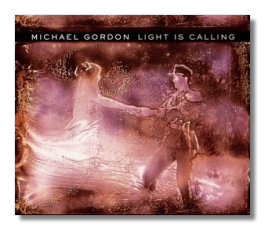
The Internet's Premier Classical Music Source
Related Links
- Latest Reviews
- More Reviews
-
By Composer
-
Collections
DVD & Blu-ray
Books
Concert Reviews
Articles/Interviews
Software
Audio
Search Amazon
Recommended Links
Site News
 CD Review
CD Review
Michael Gordon

Light is Calling
Michael Gordon, keyboards
Todd Reynolds, Victor Schulz, Ralph Farris,
Joyce Hammann, Mary Rowell, Cenovia Cummins, violins
Wendy Sutter, cello
Mark Stewart, guitar, banjo, and mandolin
Kermit Driscoll, double bass
Alex Sweeton, voice
Nonesuch 79801-2 DDD 40:25
Put together a background in new classical music with nocturnal visits to London dance clubs and you get Michael Gordon's Light is Calling, one of those rare hybrids that doesn't fall between two stools in a stinky heap. Computer musician Damian leGassick took Gordon along on some late night adventures to clubs and suggested that Gordon might make something interesting out of the combination of modern electronic dance music and Gordon's very New York-ish experience in the avant-garde jazz, rock, and classical scenes.
Light is Calling is a lively and provocative album, definitely a Saturday night experience. It's a kind of spiritual cousin to Reich Remixed, a Nonesuch CD that was released several years ago. On that CD, several progressive dance club DJs took several of Steve Reich's pieces and remixed them as if they were dance music. The result, while not typically Reichian, was revelatory. The music on this CD is Gordon's own, but I gather that leGassick and R. Luke DuBois (another big player in the electronica scene) made major contributions to the present CD, at least conceptually. Gordon's post-minimalist writing meshes perfectly with the moody bass-lines and rhythms associated with the club scene – a form of minimalism in its own right, now that I think about it. One of the eight tracks on the CD sounds like the start of John Adams's Shaker Loops, but it soon spins off in a completely different direction – Shakers at a rave, perhaps.
There's nothing new about mashing genres together. Take, for example, ELP's version of Pictures at an Exhibition or, coming from the other direction, Philip Glass's symphonies based on David Bowie albums. In almost every case, however, the hybrid is weaker than its individual components. Light is Calling is different. It is fresh and funky, yet it is disciplined. Nothing feels tacked on or wedged in. The success comes, in large part, from Gordon's refusal to rely on clichés. What he has done is idiomatic in both the electronica and new classical genres, yet not once does it sound derivative. Light is Calling has its very own sound, and it should appeal to wildly disparate listeners.
This enhanced CD has a video component which can be viewed on a PC – the short film Light is Calling directed by Bill Morrison with a musical score by Gordon. This is an amazing bonus, and worth the price of the CD by itself. Like Decasia, Morrison's recent cause celebre (also scored by Gordon), Light is Calling is an exploration of the mournful beauty that can be found in decay – specifically, in the decay of film itself. Most films made prior to 1950 are literally decomposing, a casualty of the fragile nitrate film stocks used in the first part of the 20th century. Morrison has "preserved" an excerpt of a dying film (The Bells) from 1926; his only modifications, I believe, have been to slow it down and to tint it amber. The result is both gorgeous and horrifying – a sort of cinematic portrait of Dorian Gray… or of Dante's Inferno. Faces appear to emerge from fireballs, only to warp, bubble, and be drained of their features. Gordon's infinitely sad score (which also can be heard on the audio-only portion of the CD) is a perfect musical analogue for the "meltingly" beautiful images.
Copyright © 2004, Raymond Tuttle




















